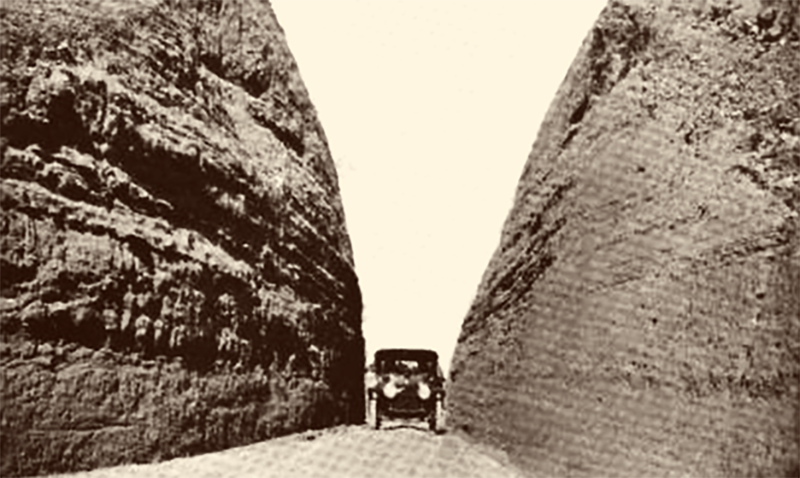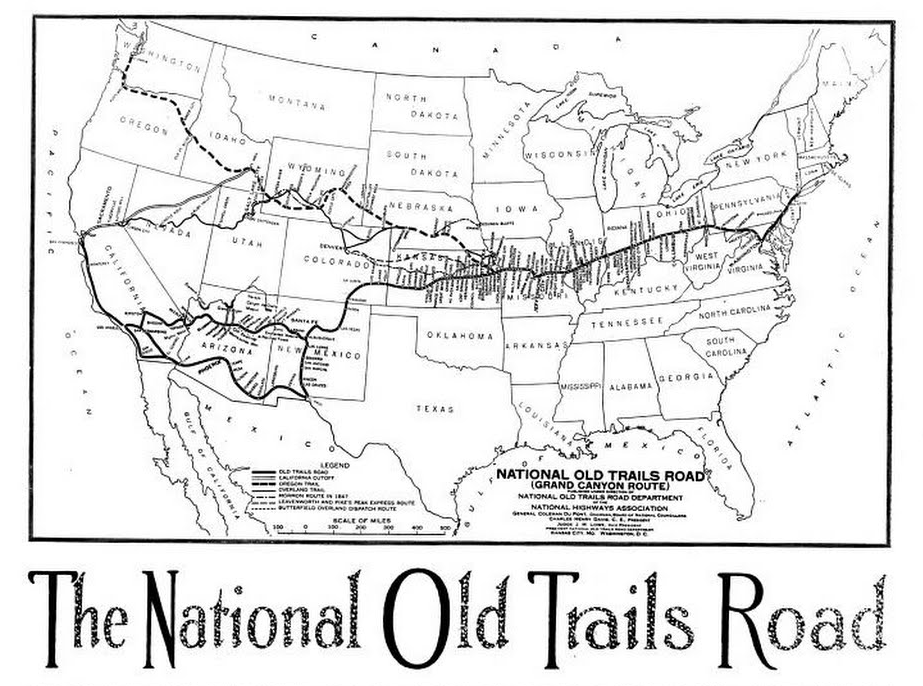
This 1915 story from Travel magazine caught our eye for its enthusiasm for stateside travel, particularly the old (old!) fashioned cross-country road trip, which is something we most strongly associated with the postwar era. But, nope, some people were doing it way earlier. This is a very lightly edited and condensed excerpt; you can read the whole thing on Google Books.
Want to see a modern map of the route detailed at the end of this story? Here you go.
The National Old Trails Road
Perpetuating the Historic Highways of America’s Pioneers
One hundred years or more after the birth of our first National Highway…our people are demanding the construction not only of the National Old Trails Road, but likewise “National Highways in the length and breadth of these United States of America. [They] will secure the benefits—social, moral, commercial, industrial, material, educational, and personal—in the progress and uplift of the American people which follow in the train of easy and free intercommunication and transit between the great centers of population and distribution, and the great productive areas of the nation,” and which will “bind the States together in a common brotherhood, and thus perpetuate and preserve the Union.
See America first? Yes, most decidedly yes! But what part of America shall do the seeing—the East or the West, the North or the South propose to see the west!
The great nations of Europe, England, France, Germany, Italy, and, in fact, the lesser states of Switzerland, Greece, and Spain, have great highways—many of them built and maintained by the central government. In the United States no such roads exist. Our national life began with the modern industrial growth of the world. Steam and electricity had been harnessed for the needs of man. Steamboats, railroads, telegraph, telephone, and electric trolley lines grew so rapidly that we failed to see or feel the need of roads. The older nations existed before these modern inventions. Their peoples had to move about. Roads filled the needs of their existence and had come into being before industrialism revolutionized modern life.
People, like water, must move or stagnate. They must run and play like the brook itself or become sluggish and dull—to themselves as well as to others. Of the seven modes of intercommunication—water, roads, postal, railroad, telegraph, telephone and wireless—only one, roads, is free to all the people of the earth. Roads are the most universally beneficial to the greatest number of people.
During 1915 our people will, more than ever before, determine upon seeing America. This, because of our two expositions in San Diego and San Francisco coming during the height of the European struggle. See America first? Yes, most decidedly yes! But what part of America shall do the seeing—the East or the West, the North or the South propose to see the west! And that is as it should be, for “See America First” usually is intended to go west instead of to Europe. But should it mean that only, and why does it now only mean that? Obviously, the latter, because concentration of wealth goes to the density of population, and this means a larger leisure class having time and money enough with which to travel for pleasure.

The northeastern section [of the USA], with one-fourth the population on about one-fourteenth of our area, has more of this kind of population to draw from than have other sections. Why has this class gone to Europe instead of west? Has it been entirely because of the greater historic interest of old countries? The greater beauty and permanency? The variety of speech, manners, and customs? Or has the root of it been the greater facilities for comfort in traveling? Or a combination of all of these elements?
On the other hand, there is no reason why “Seeing America first” should only mean going West. The East should not be passive and indifferent about it. The East should cater to the traffic which it can induce from the West just as much as the West now tries to cater for eastern traffic. We have an Atlantic shore and summer climate that the West cannot elsewhere secure. We should copy Europe and get busy for the business the West is more than ready to give us. They would see and like Niagara, the Adirondacks, White Mountains, the lakes and woods of Maine, the shores of Cape Cod and Florida, if we bestirred ourselves and made them feel at home and that they were wanted. They do all this for us. So does Europe. Why do we not reciprocate? We are beginning to.
And so we say the west should in 1915 see the East and the North as it never has before.
But back again to the National Old Trails Road! There was spent on its improvement last year more than $2,000,000 [that’s about $50.7 million in 2019]. There is already contracted for improvements during 1915 more than as much more. It is expected that over $5,000,000 will be appropriated therefor before 1916! Burton in Motor Age for February 25, 1915, gives the road conditions as follows:
“Washington to Frederick, 55 miles, about equal parts macadam and dirt; Frederick to Cumberland, 135 miles, gravel and improved road in about equal proportions; Cumberland to Wheeling, 133 miles, improved road with some gravel; Wheeling to Columbus, 128 miles, brick road almost all the way; Columbus to Indianapolis, 171 miles, permanently improved road with about 40 miles of gravel; Indianapolis to Terra Haute, 70 miles, gravel; Terra Haute to St. Louis, 173 miles, dirt; St. Louis to Kansas City, 313 miles, dirt with some stretches of improved road; Kansas City to Dodge City, 371 miles, dirt; Dodge City to La Junta, 215 miles, dirt with about 75 miles of sandy going; La Junta to Flagstaff, 811 miles, natural dirt, with the exception of about 100 miles through the mountains; Flagstaff to Kingman, 173 miles, natural dirt; Kingman to Victorville, 273 miles, sand; Victorville to Los Angeles, 104 miles, 40 miles of hard mountain road to San Bernadino and from there on macadam across Southern California.”
Here’s the route on a current map (and here’s a larger version). If you drive straight through (and you absolutely should not), it’ll take about forty-three hours.
